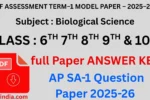SELF ASSESSMENT TERM–1 MODEL PAPER – 2025–2026
Class : 10 Subject : Biological Science
Exam Code : MR –
UDISE Code :
PEN ID :
Child Name :
Roll No :
Total Marks : 100
Duration : 3 Hours
SECTION – A : MULTIPLE CHOICE QUESTIONS
(Each question has four options. Only ONE is correct)
20 × 1 = 20 Marks
1. The functional unit of the kidney is —
మూత్రపిండం యొక్క క్రియాత్మక ఘనకము —
A) Alveolus
B) Nephron
C) Axon
D) Bronchiole
[ ]
2. The process of energy release in mitochondria is—
మైటోకాండ్రియాలో శక్తి విడుదల జరుగు ప్రక్రియ —
A) Excretion
B) Photosynthesis
C) Respiration
D) Translocation
[ ]
3. The lens inside the human eye is —
మనిషి కన్నులోని లెన్స్ —
A) Plano-convex
B) Biconvex
C) Concave
D) Cylindrical
[ ]
4. Which hormone regulates sugar levels in blood?
రక్తంలో చక్కెర స్థాయిని నియంత్రించే హార్మోన్ ఏది?
A) Adrenalin
B) Insulin
C) Thyroxine
D) Testosterone
[ ]
5. Which blood group is a universal donor?
యూనివర్సల్ డోనర్ బ్లడ్ గ్రూప్ —
A) A
B) B
C) AB
D) O
[ ]
6. The disease caused by Plasmodium parasite is —
ప్లాస్మోడియం వల్ల కలిగే వ్యాధి —
A) Polio
B) Malaria
C) Rabies
D) Typhoid
[ ]
7. Photosynthesis occurs in —
ఆహారసంయోజన జరుగునది —
A) Mitochondria
B) Chloroplast
C) Cytoplasm
D) Vacuole
[ ]
8. The part of brain responsible for balance and posture —
సమతుల్యతకు, భంగిమకు కారణమైన మెదడు భాగం —
A) Cerebrum
B) Cerebellum
C) Medulla
D) Pons
[ ]
9. Tuberculosis mainly affects —
క్షయవ్యాధి ఎక్కువగా దెబ్బతీయునది —
A) Brain
B) Lungs
C) Stomach
D) Liver
[ ]
10. The movement of food through alimentary canal is —
ఆహారం ఆహారనాళంలో కదలిక —
A) Diffusion
B) Peristalsis
C) Transpiration
D) Absorption
[ ]
11. The process of removal of wastes from the body —
శరీర వ్యర్థాలను తొలగించే ప్రక్రియ —
A) Respiration
B) Excretion
C) Reproduction
D) Coordination
[ ]
12. Which one is NOT a sexually transmitted disease?
లైంగిక సంబంధాల ద్వారా వ్యాప్తి చెందనిది —
A) AIDS
B) Syphilis
C) Hepatitis-B
D) Asthma
[ ]
13. Plants bend towards light due to —
వెలుగు వైపు మొక్కలు వంగుటకు కారణం —
A) Hydrotropism
B) Phototropism
C) Thigmotropism
D) Geotropism
[ ]
14. The structural and functional unit of nervous system —
నరవ్యవస్థ యొక్క నిర్మాణ, క్రియాత్మక ఘటకం —
A) Neuron
B) Axon
C) Cerebrum
D) Myelin
[ ]
15. Which blood cells fight diseases?
రోగాలను ఎదుర్కొనేవి —
A) RBC
B) Platelets
C) WBC
D) Plasma
[ ]
16. The process of gamete fusion is called —
గామీట్ల కలయిక ప్రక్రియ —
A) Fertilization
B) Fusion
C) Budding
D) Fission
[ ]
17. Reflex actions are controlled by —
రెఫ్లెక్స్ చర్యలను నియంత్రించేది —
A) Medulla
B) Cerebrum
C) Spinal cord
D) Heart
[ ]
18. Human heart contains —
మనిషి హృదయం కలిగి ఉండే గదులు —
A) 2
B) 3
C) 4
D) 5
[ ]
19. Carbohydrates are stored in plants as —
మొక్కలు కార్బోహైడ్రేట్లను నిల్వ చేసేది —
A) Glucose
B) Starch
C) Oil
D) Protein
[ ]
20. Microorganisms responsible for nitrogen fixation —
నైట్రోజన్ స్థిరీకరణ చేసే సూక్ష్మజీవులు —
A) E.coli
B) Rhizobium
C) Plasmodium
D) Paramecium
[ ]
SECTION – B : VERY SHORT ANSWERS
8 × 2 = 16 Marks
21. Define tissue. Give one example.
కణజాలం అంటే ఏమిటి? ఉదాహరణ ఇవ్వండి.
22. What is transpiration?
విలీనక్రియ అంటే ఏమిటి?
23. Write two differences between arteries and veins.
ఆర్టరీ, వీన్ మధ్య తేడాలు రెండు రాయండి.
24. What is synapse?
సినాప్స్ అంటే ఏమిటి?
25. Name any two plant hormones.
రెండు మొక్కల హార్మోన్లు రాయండి.
26. What is reflex action?
రెఫ్లెక్స్ చర్య అంటే ఏమిటి?
27. Write symptoms of anaemia.
అనీమియా లక్షణాలు రాయండి.
28. Write two uses of microorganisms.
సూక్ష్మజీవుల రెండు ఉపయోగాలు రాయండి.
SECTION – C : SHORT ANSWER QUESTIONS
6 × 4 = 24 Marks
29. Explain the structure of neuron with a neat diagram.
న్యూరాన్ నిర్మాణం చిత్రంతో వివరించండి.
30. Describe the process of blood clotting.
రక్తం గడ్డకట్టే విధానం వివరించండి.
31. What is photosynthesis? Explain the process.
ఆహారసంయోజన అంటే ఏమిటి? ప్రక్రియ వివరించండి.
32. Explain the mechanism of breathing in humans.
మనుషుల్లో శ్వాసక్రియ వివరణ ఇవ్వండి.
33. Describe male & female reproductive organs.
పురుష / స్త్రీ ప్రజన అవయవాలను వివరించండి.
34. Write notes on communicable and non-communicable diseases.
సంచార / అసంచార వ్యాధులపై గమనిక రాయండి.
SECTION – D : LONG ANSWER QUESTIONS
5 × 8 = 40 Marks
(Internal choice provided)
35. (A) Explain the structure and working of human heart with diagram.
చిత్రంతో కూడిన హృదయ నిర్మాణం, పని విధానం వివరించండి.
OR
35. (B) Explain double circulation with diagram.
డబుల్ సర్క్యులేషన్ చిత్రంతో వివరించండి.
36. (A) Explain the human excretory system with neat diagram.
విసర్జన వ్యవస్థను చిత్రం సహా వివరించండి.
OR
36. (B) Write an essay on kidney failure and dialysis.
కిడ్నీ వైఫల్యం, డయాలసిస్ పై వ్యాసం రాయండి.
37. (A) Describe the process of digestion in humans with labelled diagram.
జీర్ణక్రియ ప్రక్రియను చిత్రం సహా వివరించండి.
OR
37. (B) Explain enzymes and their role in digestion.
ఎంజైములు, జీర్ణక్రియలో వాటి పాత్ర వివరించండి.
38. (A) Explain the coordination system (nervous + endocrine).
నాడీ + అంతస్రావ గ్రంథుల సమన్వయ వ్యవస్థ వివరించండి.
OR
38. (B) Describe endocrine glands and hormones (any four).
నాలుగు అంతస్రావ గ్రంథులు–హార్మోన్లు వివరించండి.
39. (A) Prepare TEN questions to interview a doctor about STDs and prevention.
STDలు మరియు వాటి నివారణపై వైద్యుడిని అడగడానికి 10 ప్రశ్నలు సిద్ధం చేయండి.
OR
39. (B) Write a detailed conversation between student and teacher on “Healthy Lifestyle”.
‘హెల్దీ లైఫ్స్టైల్’ పై ఉపాధ్యాయుడు – విద్యార్థి మధ్య విశదీకృత సంభాషణ రాయండి.
ANSWER KEY (SECTION-A)
1-B
2-C
3-B
4-B
5-D
6-B
7-B
8-B
9-B
10-B
11-B
12-D
13-B
14-A
15-C
16-A
17-C
18-C
19-B
20-B


